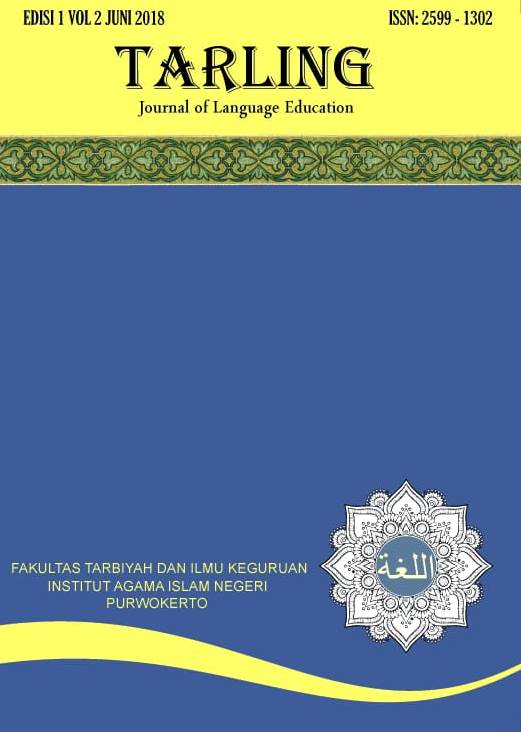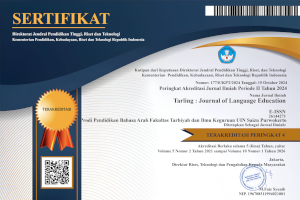Tathbiq istratijiyyah al Ta'lim al Fa'al bi al Khatithah al Dilaliyah al Ta'limiyyah fi Ta'lim Maharat al Kitabah: Dirasah fi al Barnamij al Khas li ta'lim al Lughah al 'Arabiyyah bi Jami'at maulana Malik Ibrahim al Islamiyyah al Hukumiyyah Malang
DOI:
https://doi.org/10.24090/tarling.v6i2.7063Keywords:
active learning, active learnSemantic Mapping Strategy, writing skill learningAbstract
This study aims to determine the application of active learning strategy through the Semantic Map Strategy (SMS) in learning writing skills at the Arabic Language Center (PKPBA) Universitas Islam Negeri Maulana Malik Ibrahim Malang and students' opinions on the use of it. This research is a qualitative descriptive study. Sources of data in the form of learning curriculum, learning processes, and students. The research instruments are observation and interviews. The data analysis technique used is descriptive qualitative data analysis, namely data reduction, data presentation and drawing conclusions. The results of the study show that: 1) application of active learning strategy through the Semantic Map Strategy (SMS) in learning writing skills was implemented in several stages, namely: (a) introducing the topic (b) brainstorming, (c) categorization, (d) feedback, and (e) arranging semantic maps. 2) all students feel happy and think that the application of active learning strategies through the SMS is very appropriate and effective in teaching writing. This study aims to determine the application of active learning strategy through the Semantic Map Strategy (SMS) in learning writing skills at the Arabic Language Center (PKPBA) Universitas Islam Negeri Maulana Malik Ibrahim Malang and students' opinions on the use of it. This research is a qualitative descriptive study. Sources of data in the form of learning curriculum, learning processes, and students. The research instruments are observation and interviews. The data analysis technique used is descriptive qualitative data analysis, namely data reduction, data presentation and drawing conclusions. The results of the study show that: 1) application of active learning strategy through the Semantic Map Strategy (SMS) in learning writing skills was implemented in several stages, namely: (a) introducing the topic (b) brainstorming, (c) categorization, (d) feedback, and (e) arranging semantic maps. 2) all students feel happy and think that the application of active learning strategies through the SMS is very appropriate and effective in teaching writing.Downloads
Published
2022-12-31
Issue
Section
Articles
License
Copyright (c) 2022 Rohmatulloh Salis

This work is licensed under a Creative Commons Attribution-ShareAlike 4.0 International License.
Authors who publish with this journal agree to the following terms:
- Authors retain copyright and grant the journal right of first publication with the work simultaneously licensed under a Creative Commons Attribution License that allows others to share the work with an acknowledgement of the work's authorship and initial publication in this journal.
- Authors are able to enter into separate, additional contractual arrangements for the non-exclusive distribution of the journal's published version of the work (e.g., post it to an institutional repository or publish it in a book), with an acknowledgement of its initial publication in this journal.
- Authors are permitted and encouraged to post their work online (e.g., in institutional repositories or on their website) prior to and during the submission process, as it can lead to productive exchanges, as well as earlier and greater citation of published work (See The Effect of Open Access).










